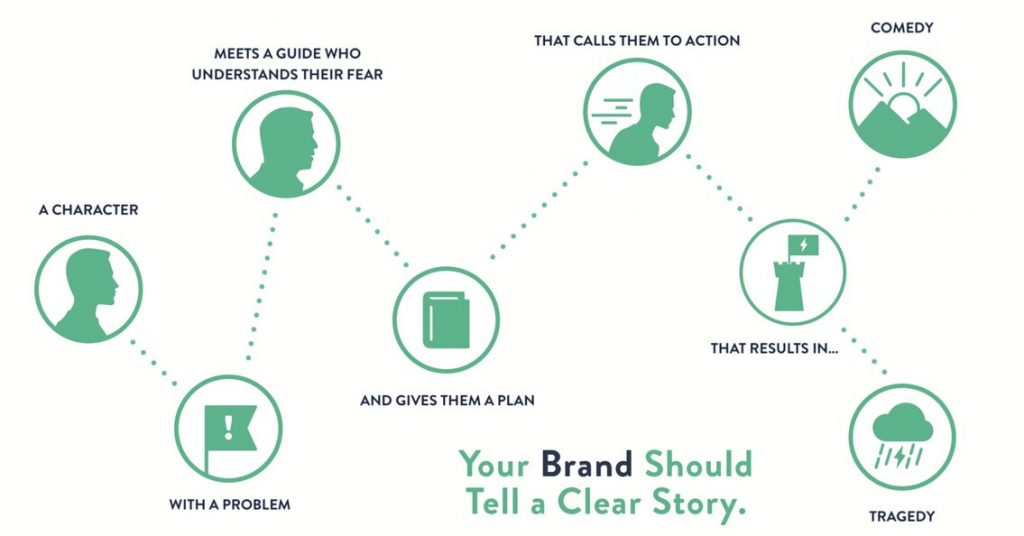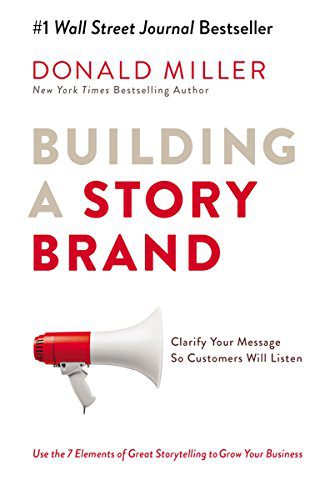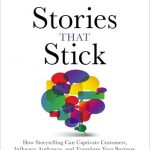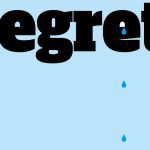“Always position your customer as the hero and your brand as the guide. Always. If you don’t, you will die.”
In Building a StoryBrand, American author and public speaker Donald Miller presents the StoryBrand 7 Part Framework inspired by principles of storytelling.
In a world filled with constant, on-demand distractions, it has become near-impossible for business owners to effectively cut through the noise to reach their customers, Miller shares the proven system he has created to help you engage and truly influence customers.
“Pretty websites don’t sell things. Words sell things. And if we haven’t clarified our message, our customers won’t listen.”
The human brain, no matter what region of the world it comes from, is drawn toward clarity and away from confusion. The reality is we aren’t just in a race to get our products to market; we’re also in a race to communicate why our customers need those products in their lives. Even if we have the best product in the marketplace, we’ll lose to an inferior product if our competitor’s offer is communicated more clearly.
All great stories are about survival
All great stories are about survival—either physical, emotional, relational, or spiritual. A story about anything else won’t work to captivate an audience. Nobody’s interested. This means that if we position our products and services as anything but an aid in helping people survive, thrive, be accepted, find love, achieve an aspirational identity, or bond with a tribe that will defend them physically and socially, good luck selling anything to anybody. These are the only things people care about. We can take that truth to the bank. Or to bankruptcy court, should we choose to ignore it as an undeniable fact.
The Value of Storytelling
A story is a sense-making device. It identifies a necessary ambition, defines challenges that are battling to keep us from achieving that ambition, and provides a plan to help us conquer those challenges. When we define the elements of a story as it relates to our brand, we create a map customers can follow to engage our products and services.
Story is atomic. It is perpetual energy and can power a city. Story is the one thing that can hold a human being’s attention for hours.
Nobody can look away from a good story. In fact, neuroscientists claim the average human being spends more than 30 percent of their time daydreaming . . . unless they’re reading, listening to, or watching a story unfold. Why? Because when we are engaged in a story, the story does the daydreaming for us.
Story is the greatest weapon we have to combat noise, because it organizes information in such a way that people are compelled to listen.
BUSINESS HAS AN ENEMY – Noise
Noise has killed more ideas, products, and services than taxes, recessions, lawsuits, climbing interest rates, and even inferior product design. I’m not talking about the noise inside our business; I’m talking about the noise we create as a business. What we often call marketing is really just clutter and confusion sprayed all over our websites, e-mails, and commercials. And it’s costing us millions.
“What we think we are saying to our customers and what our customers actually hear are two different things. And customers make buying decisions not based on what we say but on what they hear.”
STORY MAKES MUSIC OUT OF NOISE
Technically speaking, music and noise are similar. Both are created by traveling sound waves that rattle our eardrums. Music, however, is noise that has been submitted to certain rules that allow the brain to engage on a different level.
Story is similar to music. A good story takes a series of random events and distills them into the essence of what really matters.
Story in a Nutshell
Here is nearly every story you see or hear in a nutshell:
A CHARACTER who wants something encounters a PROBLEM before they can get it. At the peak of their despair, a GUIDE steps into their lives, gives them a PLAN, and CALLS THEM TO ACTION. That action helps them avoid FAILURE and ends in a SUCCESS.

These seven basic plot points are like chords of music in the sense that you can use them to create an infinite variety of narrative expression. Just like playing the guitar, with these seven chords you can create any number of songs. Varying too far from these chords, however, means you risk descending into noise.
The Three Crucial Questions
Remember, the greatest enemy our business faces is the same enemy that good stories face: noise. At no point should we be able to pause a movie and be unable to answer three questions:
1.What does the hero want?
2.Who or what is opposing the hero getting what she wants?
3.What will the hero’s life look like if she does (or does not) get what she wants?
If these three questions can’t be answered within the first fifteen to twenty minutes, the story has already descended into noise and will almost certainly fail at the box office.
DOES YOUR MARKETING PASS THE GRUNT TEST?
There are three questions potential customers must answer if we expect them to engage with our brand. And they should be able to answer these questions within five seconds of looking at our website or marketing material:
1.What do you offer?
2.How will it make my life better?
3.What do I need to do to buy it?
The critical question is this: “Could a caveman look at your website and immediately grunt what you offer?
“Think of the StoryBrand Framework as a recipe for a loaf of bread. Failure is like salt: use too much and you’ll ruin the flavor; leave it out and the recipe will taste bland. Regardless, the point is this: your story needs stakes.”
THE STORYBRAND FRAMEWORK

1. A Character
STORYBRAND PRINCIPLE ONE: THE CUSTOMER IS THE HERO, NOT YOUR BRAND.”
A major paradigm shift in the SB7 Framework is that the customer is the hero of the story, not your brand. When we position our customer as the hero and ourselves as the guide, we will be recognized as a trusted resource to help them overcome their challenges.
Once we identify who our customer is, we have to ask ourselves what they want as it relates to our brand. The catalyst for any story is that the hero wants something. The rest of the story is a journey about discovering whether the hero will get what they want.
Unless we identify something our customer wants, they will never feel invited into the story we are telling.
2. Has a Problem
STORYBRAND PRINCIPLE TWO: COMPANIES TEND TO SELL SOLUTIONS TO EXTERNAL PROBLEMS, BUT CUSTOMERS BUY SOLUTIONS TO INTERNAL PROBLEMS.
In its purest form, a story starts with a character who lives in peace and stability. Suddenly that stability is disrupted: a bomb goes off, someone is kidnapped, or a disaster strikes. The hero then sets out on a journey to return to the peaceful life they once enjoyed.
Customers are attracted to us for the same reason heroes are pulled into stories: they want to solve a problem that has, in big or small ways, disrupted their peaceful life.
By talking about the problems our customers face, we deepen their interest in everything we offer.
3. And Meets a Guide
STORYBRAND PRINCIPLE THREE: CUSTOMERS AREN’T LOOKING FOR ANOTHER HERO; THEY’RE LOOKING FOR A GUIDE.
If heroes in a story could solve their own problems, they would never get into trouble in the first place. That’s why storytellers, through the centuries, have created another character to help the hero win.
Brands that position themselves as heroes unknowingly compete with their potential customers. Every human being wakes up each morning and sees the world through the lens of a protagonist. The world revolves around us, regardless of how altruistic, generous, and selfless a person we may be. Each day is, quite literally, about how we encounter our world. Potential customers feel the same way about themselves. They are the center of their world.
4. Who Gives Them a Plan
STORYBRAND PRINCIPLE FOUR: CUSTOMERS TRUST A GUIDE WHO HAS A PLAN.
Making a purchase is a huge step, especially if our products or services are expensive. What customers are looking for, then, is a clear path we’ve laid out that takes away any confusion they might have about how to do business with us.
In almost every story, the guide gives the hero a plan, or a bit of information, or a few steps they can use to get the job done. People are looking for a philosophy they can embody or a series of steps they can take to solve their problems.
5. And Calls Them to Action
STORYBRAND PRINCIPLE FIVE: CUSTOMERS DO NOT TAKE ACTION UNLESS THEY ARE CHALLENGED TO TAKE ACTION.
In stories, characters don’t take action on their own. They must be challenged. If we’re telling a story about a man who needs to lose thirty pounds and suddenly decides to do it of his own volition, the audience will check out. Why? Because that’s not how life works. There needs to be a reason.
Human beings take action when their story challenges them to do so.
Until we call our customers to action, they simply watch us, but when we call them to action (the right way), they will engage.
6. That Helps Them Avoid Failure
STORYBRAND PRINCIPLE SIX: EVERY HUMAN BEING IS TRYING TO AVOID A TRAGIC ENDING.
Stories live and die on a single question: What’s at stake? If nothing can be gained or lost, nobody cares.
If there is nothing at stake in a story, there is no story. Likewise, if there’s nothing at stake in whether or not I buy your product, I’m not going to buy your product. After all, why should I? Simply put, we must show people the cost of not doing business with us.
Brands that help customers avoid some kind of negativity in life (and let their customers know what that negativity is) engage customers for the same reason good stories captivate an audience: they define what’s at stake.
7. And Ends in a Success
STORYBRAND PRINCIPLE SEVEN: NEVER ASSUME PEOPLE UNDERSTAND HOW YOUR BRAND CAN CHANGE THEIR LIVES. TELL THEM
We must tell our customers how great their life can look if they buy our products and services. Everybody wants to be taken somewhere. If we don’t tell people where we’re taking them, they’ll engage another brand.
Every Story Needs a Villain
The villain is the number-one device storytellers use to give conflict a clear point of focus. Screenwriters and novelists know the stronger, more evil, more dastardly the villain, the more sympathy we will have for the hero and the more the audience will want them to win in the end. This translates into audience engagement.
Villian
If we want our customers’ ears to perk up when we talk about our products and services, we should position those products and services as weapons they can use to defeat a villain. And the villain should be dastardly.
Here are four characteristics that make for a good villain on your StoryBrand BrandScript:
1.The villain should be a root source. Frustration, for example, is not a villain; frustration is what a villain makes us feel. High taxes, rather, are a good example of a villain.
2.The villain should be relatable. When people hear us talk about the villain, they should immediately recognize it as something they disdain.
3.The villain should be singular. One villain is enough. A story with too many villains falls apart for lack of clarity.
4.The villain should be real. Never go down the path of being a fearmonger. There are plenty of actual villains out there to fight. Let’s go after them on behalf of our customers.
The Three Levels of Conflict
A villain is the antagonist because the villain causes the hero serious problems. That’s obvious. But what’s less obvious is that in a story, there are three levels of problems that work together to capture a reader’s or a moviegoer’s imagination.
The three levels of problems heroes (and customers) face are
- External Problems
- Internal Problems
- Philosophical Problems
In a story, a villain initiates an external problem that causes the character to experience an internal frustration that is, quite simply, philosophically wrong. These are also the three levels of problems a customer hopes to solve when they buy a product.
EXTERNAL PROBLEMS
In stories, the external problem is often a physical, tangible problem the hero must overcome in order to save the day. The problem might manifest itself as a ticking time bomb or a runaway bus, or maybe even a combination of the two: a bomb on a bus that will go off if Keanu Reeves doesn’t keep the speed above fifty miles per hour!
The external problem works like a prized chess piece set between the hero and the villain, and each is trying to control the piece so they can win the game.
INTERNAL PROBLEMS
By limiting our marketing messages to only external problems, we neglect a principle that is costing us thousands and potentially millions of dollars. That principle is this:
Companies tend to sell solutions to external problems, but people buy solutions to internal problems.
What stories teach us is that people’s internal desire to resolve a frustration is a greater motivator than their desire to solve an external problem.
This is where most brands make a critical mistake. By assuming our customers only want to resolve external problems, we fail to engage the deeper story they’re actually living. The truth is, the external problems we solve are causing frustrations in their lives and, just like in a story, it’s those frustrations that are motivating them to call you.
PHILOSOPHICAL PROBLEMS
The philosophical problem in a story is about something even larger than the story itself. It’s about the question why. Why does this story matter in the overall epic of humanity?
A philosophical problem can best be talked about using terms like ought and shouldn’t. “Bad people shouldn’t be allowed to win” or “People ought to be treated fairly.
If we really want our business to grow, we should position our products as the resolution to an external, internal, and philosophical problem and frame the “Buy Now” button as the action a customer must take to create closure in their story.
How some successful brands we all know about have positioned the purchasing of their products as the resolution to external, internal, and philosophical problems:
TESLA MOTOR CARS:
Villain: Gas guzzling, inferior technology
External: I need a car.
Internal: I want to be an early adopter of new technology.
Philosophical: My choice of car ought to help save the environment.
NESPRESSO HOME COFFEE MACHINES:
Villain: Coffee machines that make bad coffee
External: I want better-tasting coffee at home.
Internal: I want my home coffee machine to make me feel sophisticated.
Philosophical: I shouldn’t have to be a barista to make a gourmet coffee at home.
“The fatal mistake some brands make, especially young brands who believe they need to prove themselves, is they position themselves as the hero in the story instead of the guide”
All the Best in your quest to get Better. Don’t Settle: Live with Passion.



2 Comments
Pingback: The StoryBrand Framework. – Lanre Dahunsi
Pingback: 100 Books Reading Challenge 2021 | Lanre Dahunsi